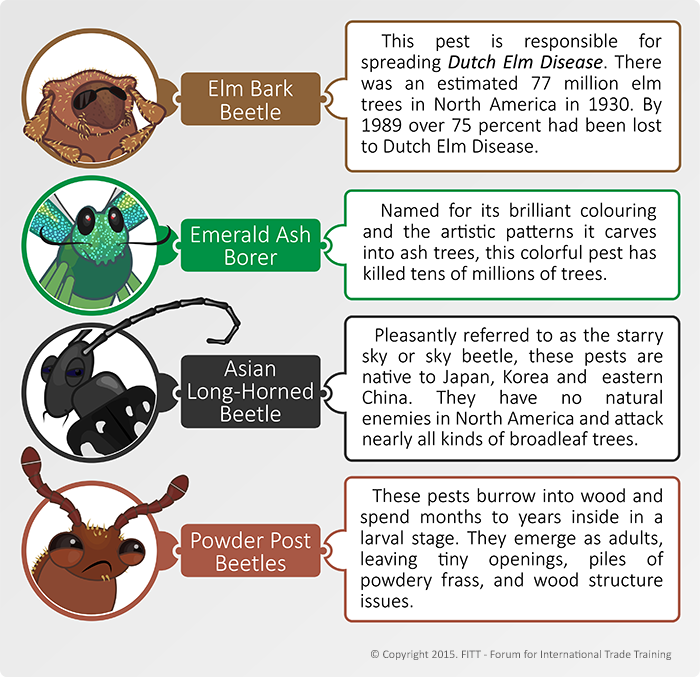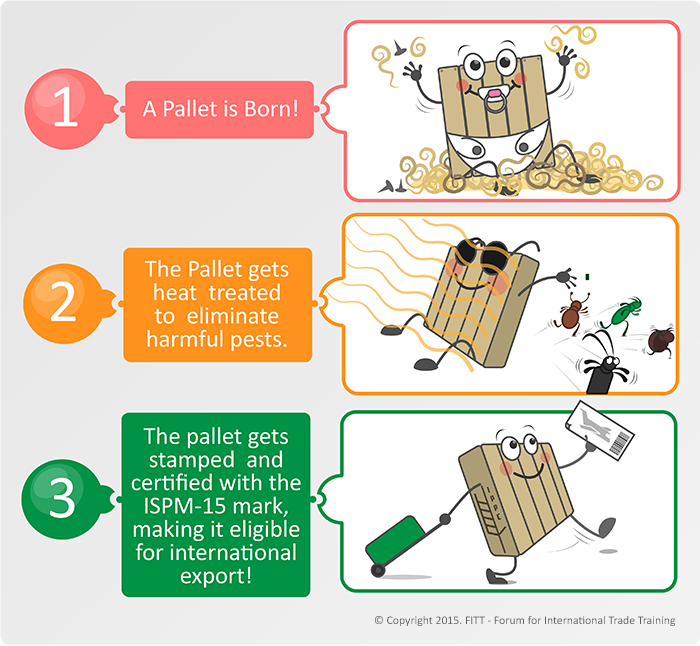 There are said to be billions of pallets circulating around the world today. About eight percent of them are made of plastic and five percent of metal, but a resounding 87 percent of pallets in use are made of wood.
There are said to be billions of pallets circulating around the world today. About eight percent of them are made of plastic and five percent of metal, but a resounding 87 percent of pallets in use are made of wood.
While wooden pallets are cheaper, readily available, more customizable and even recyclable, exporters do face the responsibility of ensuring that while they’re shipping their goods to exciting new markets around the world, they are also avoiding the spread of pests that can cause ecological nightmares!

If the threat of accidentally causing mass deforestation around the globe doesn’t make you nervous, then first of all, shame on you! Secondly, failing to take the steps to ensure your wooden pallets are pest-free can cause disruptions for your supply chain, upset your cross-border customers, and most likely cut a good chunk of green off your bottom line.
So as an exporter, what should you do about it?
Getting the right pallets to ensure smooth cross-border transportation
Like snowflakes or chubby newborn babies, no two wooden pallets are exactly the same. There are created in different lengths and widths, with different numbers of cross boards, and they may be made of hardwood, softwood and in some cases plywood.
But regardless of esthetics and origins, all pallets—as well as other forms of wood packaging, such as crates and cable reels—must be properly treated and certified before they can travel permissibly across international borders.
Heat treatment is the most commonly accepted method of treating wooden pallets.
This involves heating the pallets in kilns to bring the core temperature of the wood to 56 degrees Celsius for at least 30 minutes; sufficient time to kill any pests residing within.
Not only is this option the safest (compared to using chemicals such as methyl bromide), but it also complies with the International Plant Protection Convention’s International Standards for Phytosanitary Measures (ISPM) No. 15. These standards were agreed upon in 2004 by countries around the world looking to form a solution for the global spread of harmful pests.
After being properly treated, pallets can then be certified with an ISPM-15 mark.

“The Canadian government has been monitoring shipments overseas and as long as people are using certified wood packaging, there hasn’t been any problems reported for at least five years here,” says Brian Isard, General Manager of the Canadian Wood Pallet and Container Association (CWPCA).
But the problem is there are exporters who are not using compliant wood packaging certified under the Canadian Wood Packaging Certification Program.
What happens when you don’t use the ISPM-15 certification program?
Uncertified pallets find themselves destined for foreign borders for a number of reasons.
The exporter might be unaware of their responsibility to comply with international phytosanitary regulations and the severe penalties for failing to do so, or uncertified wooden pallets might accidentally find their way into the midst of a shipment that is ISPM-15 certified.
“I saw it happen once a couple of years ago,” says Margaret Duhamel, Import Manager at Icecorp Logistics Inc. “Eight pallets got all the way to Canada from Europe and customs decided to look in the container. Seven pallets were okay but one was not.”
The entire container had to go back because of the one pallet. They wouldn’t let us unload the seven good pallets and destroy the eighth; it all had to go back to origin.
The shipper who sent the pallets had to pay for the return and then also had to pay to get the shipment sent back into Canada. This meant that the purchaser was severely delayed in getting his product.
Of course, there are also cases in which exporters think no one will notice and they can simply use whatever pallets they have in stock. But someone will notice, and the consequences aren’t fun.
“There are also concerns from the U.S. perspective that the application of the mark (ISPM-15) isn’t being properly monitored in countries other than Canada and the US.” says Isard.

While the ISPM-15 mark, or the IPPC stamp, is an international standard with international regulations, the certification programs in place in each country are responsible for guiding and monitoring these standards at registered facilities—including guidelines for the legibility of stamps and where the stamps are applied on the wood packaging.
There are even some concerns in the global marketplace that the marks are being acquired improperly by non-registered suppliers of wood packaging, and are being used improperly, he says.
We haven’t seen evidence that the mark is being abused in Canada, but what we have seen is very strict enforcement at U.S. border points.
“They’ve been increasing the monitoring of imports that use certified wood packaging for stamp legibility, and when imports are identified with unmarked wood packaging other than from Canada, there are restrictions for entry. That should be a concern for international shippers.”
There’s currently a bilateral exemption in place for pallets being shipped back and forth across U.S. and Canadian borders, which means there are no certification requirement for wood packaging. However, both countries recently agreed to phase out the exemption. This means wood packaging moving between the two countries would need to comply with the international standard. While the implementation date for termination of the current bilateral exemption was originally scheduled for 2015, it has been pushed back. Regardless, most in the industry are working based on the assumption that the exemption won’t last much longer.
What will happen to my shipment if I send uncertified pallets?
Like in Margaret’s story, shipments destined for international export that contain uncertified pallets will be held at the border, and you’ll have to replace the pallets in question or have them certified, costing you valuable time and money.
Since ISPM-15 is an international standard, you’ll face issues like this in exporting to any country that’s a signatory to the International Plant Protection Convention.
For example, what would happen if you made a shipment to China and your wood packaging didn’t meet ISPM-15 regulations upon arrival? This could involve ISPM-15 stamps that aren’t applied properly, that customs agents suspect that the wood packaging is not properly certified, or even that they see actual insects on the lumber.
“Typically what happens is the customs agents immediately remove the imported product with the suspect wood-packaging to quarantine, and it becomes a very expensive process for the shipper,” says Isard.
The goods can either be ordered removed and returned to point of origin, or the wood packaging can to be sent for supplementary treatment to the ISPM-15 standard in the destination country with all associated costs at the expense of the shipper.
Normally, ensuring the pallets are all certified is the shippers responsibility, agrees Margaret. But some shippers are unaware, so it’s always best to alert your shipper that they need to make sure all pallets sent are properly treated to the ISPM-15 standard.
The bottom line is, whether you’re exporting or importing, save yourself some trouble. Do everything you can to ensure all pallets being sent are ISPM-15 certified!
Have you ever experienced difficulty importing products because they arrived on improperly certified wooden pallets?







disqus comments